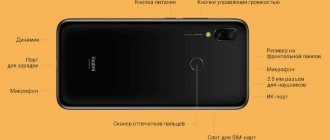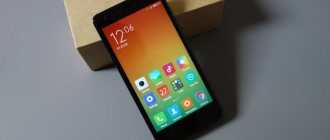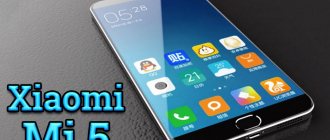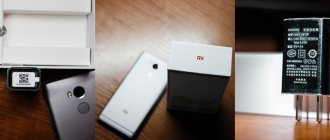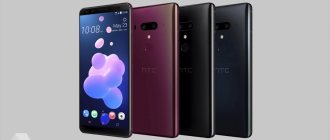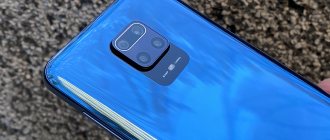- Main settings
- Equipment
- Design
- Dimensions
- Screen
- CPU
- Autonomy
- Cameras
- Wireless technologies
- Operating system features
- conclusions
A huge number of functions, amazing performance, amazing battery life - do you think a smartphone with such characteristics exists in reality?
If you are in doubt, we invite you to study our review of Xiaomi Mi Max 2, which will change your understanding of modern devices. It was released quite recently, but has already aroused genuine interest among fans of cool gadgets. Particular attention is drawn to the improved hardware, which, in comparison with its predecessor, looks solid and powerful.
Brief characteristics
We invite you to get acquainted with the main technical parameters of the new product. More detailed information can be found in our article.
| Display | FullHD screen with a diagonal of 6.44 inches |
| CPU | Qualcomm Snapdragon 625 |
| Battery capacity | 5300 mAh |
| Main camera | 12 MP |
| SIM cards | microSIM and nanoSIM |
| Video chip | Adreno 506 |
| Memory card | MicroSD, 128 GB |
| RAM | 4 GB |
| Dimensions and weight | Dimensions 88.7x174.1x7.6 mm, 211 grams |
Display
Xiaomi Mi Max 2 64gb smartphone review shows that we have a gorgeous IPS panel with a diagonal of 6.44 inches and FullHD resolution. The viewing angles are maximum; when you look at the screen at an angle, nothing is distorted. There is a significant reserve of brightness, so it is convenient to use the smartphone even on a bright summer day. The average pixel density is 342 ppi. If you hold the screen close to your face, you can see individual pixels, but in everyday life you don’t notice this.
Xiaomi Mi Max 2 black review in Russian showed that the display has a protective glass with a high-quality oleophobic coating, on which the finger glides smoothly and remaining fingerprints are easily removed.
If you are somehow not satisfied with the factory calibration, you can always go to the settings menu and adjust the color rendition to suit you. When compiling a review of the Xiaomi Mi Max 2 4 gb 64gb mde40, we found an interesting reading mode, which contains many useful settings for less eye fatigue. You can set the schedule for its activation, the brightness of the yellow, and even select the applications in which it will be active.
What's included?
The device is delivered in a stylish snow-white box, on which there is no decor other than the company logo. Beauty lies in simplicity, doesn't it? The manufacturer packed the phablet very securely to eliminate the possibility of damage during transportation.
Looking inside the package, you will find a “clip” to open the slot, a charger, documentation and a USB Type-C cable. All elements are made of high-quality materials that are pleasant to the touch.
Stylish design
The simple and uncomplicated appearance of the device classifies it as a classic model. It completely lacks end plastic inserts, and the aluminum body covers all edges except the front. To avoid shielding of radio signals from the outside, there are special grooves for antennas, which in their shape correspond to the curved lines of the body.
Among the pleasant bonuses is a significant reduction in the parameters of the unsightly black frame, which has become almost invisible. If in the previous model its thickness was 1.5 mm, now it is only 0.7 mm. There is a feeling that it simply does not exist. It looks especially chic in products made in a light palette, since the display practically merges with the front surface of the gadget.
The oleophobic coating of Gorilla Glass 4 does its job perfectly. Of course, it cannot be said that fingerprints do not appear on it at all, but the display still does not require constant and tedious cleaning.
In Xiaomi Mi Max 2, colors are represented in only 3 shades - silver, gold and gray. All three options combine perfectly with the snow-white front panel, leaving a feeling of harmony and tenderness.
Review of the Xiaomi Mi Max 2 smartphone. The largest screen and the most capacious battery in the Mi family
with the largest screen and the most capacious battery in the Mi family
Content
- Specifications
- Equipment
- Appearance and ease of use
- Screen
- Camera
- Telephone and communications
- Software and multimedia
- Performance
- Thermal photographs
- Playing video
- Battery life
- Bottom line
Last season, the Chinese company Xiaomi, which a couple of years ago was one of the few to perform well in the segment of small flagship smartphones with top-end specifications, marked the release of almost the largest tablet phone on the market with a huge screen, balanced characteristics and impressive battery life. This product, which is not entirely familiar to Xiaomi, nevertheless appealed to fans of the brand, and Mi Max became a hit. It is quite natural that the manufacturer did not stop and, on the wave of success, released an update to this popular solution this season - Mi Max 2. The new product retained the best features of its predecessor, and some dubious aspects were softened. Read more about all this in our Xiaomi Mi Max 2 review.
Main characteristics of Xiaomi Mi Max 2
- SoC Qualcomm Snapdragon 625, 8 cores Cortex-A53 (2.0 GHz)
- GPU Adreno 506 (650 MHz)
- Operating system Android 7.1.1, MIUI 8.5
- Touch display IPS 6.44″, 1920×1080, 342 ppi
- Random access memory (RAM) 4 GB, internal memory 64/128 GB
- Support Nano-SIM (1 pc.), Micro-SIM (1 pc.)
- MicroSD support up to 128 GB
- GSM/GPRS/EDGE networks (850/900/1800/1900 MHz)
- WCDMA/HSPA+ networks (850/900/1900/2100 MHz)
- Networks LTE Cat.12, FDD (B1/B3/B5/B7/B8), TD (B38—B41)
- Wi-Fi 802.11a/b/g/n/ac (2.4 and 5 GHz) MU-MIMO
- WiFi Display, WiFi Direct
- Bluetooth 4.2
- GPS, A-GPS, Glonass, BDS
- USB Type-C, USB OTG
- IR port
- Main camera 12 MP, f/2.2, autofocus, 4K video
- Front camera 5 MP, f/2.0, fixed. focus
- Proximity sensor, light sensor, magnetic field sensor, fingerprint sensor, accelerometer, gyroscope, step counter
- Battery 5300 mAh, Quick Charge 3.0
- Dimensions 174×89×7.6 mm
- Weight 211 g
| average price | |
| Xiaomi Mi Max 2 (64 GB) | Xiaomi Mi Max 2 (128 GB) |
| find out the price | find out the price |
| Retail offers Xiaomi Mi Max 2 (64 GB) | |
| find out the price | |
| Retail offers Xiaomi Mi Max 2 (128 GB) | |
| find out the price | |
Contents of delivery
Xiaomi Mi Max 2 received a standard box for packaging, made of very thick and hard cardboard. The lid, I must say, fits too tightly, and no additional means are provided for its convenient removal. Therefore, you have to shake it many, many times until the pan crawls out at least a little. Frankly speaking, it is not the most convenient packaging to open.
The content, as usual, is very sparse. There is nothing in the box except a charger with variable maximum output current and voltage (3 A 5 V / 2 A 9 V / 1.5 A 12 V) and a connecting cable. The tool for removing the SIM card is mounted on a paper tab as standard.
Appearance and ease of use
The body of Xiaomi Mi Max 2 is completely made of metal. There are no end plastic inserts here; a solid aluminum trough completely covers all edges, having only one gluing point with the front glass. Accordingly, so that the metal does not shield radio signals, grooves are cut out from the outside for the antennas. They are curved in a modern way in accordance with the lines of the body, repeating its shape.
Otherwise, this is a completely typical representative of Xiaomi smartphones, with the most simple and concise design. He is not beautiful and not repulsive, simple and calm.
The case is very large, wide, but quite thin: its thickness is only 7.6 mm, and due to the highly rounded edges, the case feels even thinner in the hand, the edges almost dig into the palms, because such a wide case requires a fairly strong grip In a word, this is not the most thoughtful option; for a large and heavy device (weighing 211 g), the side edges must be made flatter and wider, otherwise the smartphone spins in your hand like a bar of soap and every time tries to fall out on the floor.
The matte smooth metal also makes the Xiaomi Mi Max 2 quite slippery to hold in your hand. But the good grease-repellent coating of the Gorilla Glass front glass and the non-staining metal of the back make the device practically impervious to fingerprints; the smartphone retains its presentable appearance for a long time without the need for constant wiping with a cloth.
The all-metal body without plastic inserts is bend-resistant, practical, reliable and can last for a long time, you just need to try not to drop it on the floor. To do this, it is better to immediately purchase a case, since, as already mentioned, a wide, heavy and very thin device with sharp sides is difficult to hold in the hand.
Now let's move on to listing the elements located on the body of the Xiaomi Mi Max 2 - there are more of them here than usual. Among the non-standard features is a useful IR transmitter on the top end, which, using the built-in Mi Remote program, turns the smartphone into a convenient universal remote control for home appliances. The program immediately recognized an old Philips TV without any problems, which not all programs of this kind can handle now.
In addition, at the top end you can find a 3.5 mm audio output for headphones and a small hole for an auxiliary microphone.
The bottom end is given over to a universal USB Type-C connector; two rows of holes are cut on either side of it. Behind the right is a speaker, and behind the left, perhaps, a conversational microphone, but it usually does not require so many holes.
The mechanical power and volume keys are located on the side under the right hand; they are not very large, made of metal, quite rigid and with a short travel. The keys are not the most comfortable, but you can get used to them.
The rear panel is usually given over to a camera module with flash, as well as a fingerprint scanner. None of these elements protrude beyond the surface; the device lies stable on the table. Unlike the first version of Mi Max, here the flash is placed to the left of the camera module. It is double and shines brightly. The scanner performs recognition clearly and quickly, and you can place your finger at any angle. Registration of up to 5 fingers is supported.
The front panel is completely covered with 2.5D Gorilla Glass with sloping edges. Above the screen, in addition to the grille and sensors covering the speaker, there is also an LED event indicator; it shines with a milky dot while charging, but does not work as a notification about missed voice calls.
At the bottom of the front panel there is a row of touch buttons that have their own customizable backlight. Traditionally for the MIUI interface, additional functionality is added to the buttons, which involves holding them for a long time.
Xiaomi Mi Max 2 on the Russian market can be purchased in golden color, as in our photographs, as well as in black.
Screen
Xiaomi Mi Max 2 is equipped with an IPS display with protective 2.5D Gorilla Glass with sloping edges. The physical dimensions of the screen are 80x143 mm with a diagonal of 6.44 inches. The screen resolution is 1920x1080, the pixel density is about 342 ppi. For a screen with such a huge area, the resolution and dot density are perhaps too small. It is also worth noting that the notorious black frame around the display, for which Xiaomi has always been so criticized, remained in place, but became about half as thin. However, it is still clearly visible, and the total width of the frame around the screen together with the sides of the case is 4 mm on the sides, 17 mm on the bottom, and 14 mm on the top. That is, there is no talk of any “framelessness” here.
You can adjust the display brightness manually or use automatic settings based on the ambient light sensor. The AnTuTu test diagnoses support for 10 simultaneous multi-touch touches. It is possible to activate the screen by double tapping.
A detailed examination using measuring instruments was carried out by the editor of the “Monitors” and “Projectors and TV” sections Alexey Kudryavtsev
. Here is his expert opinion on the screen of the sample under study.
The front surface of the screen is made in the form of a glass plate with a mirror-smooth surface that is scratch-resistant. Judging by the reflection of objects, the anti-glare properties of the screen are approximately the same as those of the Google Nexus 7 (2013) screen (hereinafter simply Nexus 7). For clarity, here is a photograph in which a white surface is reflected when the screens are turned off (on the left is the Nexus 7, on the right is the Xiaomi Mi Max 2, then they can be distinguished by size, and the Nexus 7 in the photographs for comparison of images on the screens is located under the device under test):
The screen of the Xiaomi Mi Max 2 is slightly lighter (brightness according to photographs is 124 versus 117 for the Nexus 7). The ghosting of reflected objects in the Xiaomi Mi Max 2 screen is very weak, this indicates that there is no air gap between the layers of the screen (more specifically, between the outer glass and the surface of the LCD matrix) (OGS - One Glass Solution type screen). Due to the smaller number of boundaries (glass/air type) with very different refractive indices, such screens look better in conditions of intense external illumination, but their repair in the case of cracked external glass is much more expensive, since the entire screen has to be replaced. The outer surface of the screen has a special oleophobic (grease-repellent) coating (even better in efficiency than that of the Nexus 7), so fingerprints are removed much more easily and appear at a lower speed than with regular glass.
When manually controlling the brightness and displaying the white field in full screen, the maximum brightness value was about 520 cd/m², the minimum was 1.0 cd/m². The maximum brightness is very high, and given the good anti-glare properties, readability should be good even on a sunny day outdoors. In complete darkness, the brightness can be reduced to a comfortable value. There is automatic brightness adjustment based on the light sensor (it is located to the left of the front speaker slot). In automatic mode, as external lighting conditions change, the screen brightness both increases and decreases. The operation of this function depends on the position of the brightness adjustment, with which the user can try to set the desired brightness level in the current conditions. If you do not interfere, then in complete darkness the auto-brightness function reduces the brightness to 4 cd/m² (too dark), in an artificially lit office (approximately 550 lux) it sets it to 160 cd/m² (normal), in a very bright environment (corresponds to the lighting on a clear day outdoors, but without direct sunlight - 20,000 lux or a little more) increases to 520 cd/m² (to the maximum, which is what is needed). We were not entirely satisfied with the result, so in conditions of complete darkness we slightly moved the slider to the right, and for the three conditions indicated above, we got the following values: 14, 160 and 520 cd/m² (suitable values). It turns out that the auto-brightness function works adequately and to some extent allows the user to customize their work to individual requirements. At any brightness level, there is no significant backlight modulation, so there is no screen flicker.
This smartphone uses an IPS matrix. The microphotographs show a typical IPS subpixel structure:
For comparison, you can see the gallery of microphotographs of screens used in mobile technology.
The screen has good viewing angles without a significant color shift even with large deviations of the view from perpendicular to the screen and without inverting (except for the very darkest when deviating along one diagonal) shades. For comparison, here are photographs in which identical images are displayed on the screens of Xiaomi Mi Max 2 and Nexus 7, while the brightness of the screens was initially set to approximately 200 cd/m², and the color balance on the camera was forcibly switched to 6500 K.
There is a white field perpendicular to the screens:
Note the good uniformity of brightness and color tone of the white field.
And a test picture:
The color contrast on the Xiaomi Mi Max 2's screen is slightly too high, and the color balance between the Nexus 7 and the tested screen is slightly different. The photo was taken with the default Automatic contrast
in screen settings:
In profile Increaser contrast
the color contrast is even higher, but in the
Standard
there seems to be no increase in color contrast, and this is the profile you should choose first. This is what the test image looks like:
Unfortunately, in this profile, as in the Increaser contrast
Color temperature adjustment is not available. It's difficult to understand what motivated the developers when they limited the color rendering options so much. Surely this is done solely for the benefit of the user.
Now at an angle of approximately 45 degrees to the plane and to the side of the screen:
It can be seen that the colors did not change much on both screens, but on the Xiaomi Mi Max 2 the contrast decreased to a greater extent due to the strong brightening of blacks, and it also began to show signs of inverting dark shades.
And a white field:
The brightness at an angle of the screens has decreased, but in the case of the Xiaomi Mi Max 2 the decrease in brightness is less (to avoid strong darkening, for shots at an angle the shutter speed has been increased compared to previous photos). When deviated diagonally, the black field brightens greatly and acquires a purple or reddish tint. The photographs below demonstrate this (the brightness of the white areas in the direction perpendicular to the plane of the screens is the same!):
And from another angle:
When viewed perpendicularly, the uniformity of the black field is very good:
The contrast (approximately in the center of the screen) is normal - about 820:1. The response time for the black-white-black transition is 16 ms (8 ms on + 8 ms off). The transition between halftones of gray 25% and 75% (based on the numerical value of the color) and back takes a total of 25 ms. The gamma curve, constructed using 32 points with equal intervals based on the numerical value of the shade of gray, did not reveal any blockage in either the highlights or the shadows. The exponent of the approximating power function is 2.34, which is slightly higher than the standard value of 2.2. In this case, the real gamma curve deviates slightly from the power-law dependence:
When selecting the Automatic contrast
There is a not very aggressive dynamic adjustment of the backlight brightness in accordance with the nature of the displayed image; we did not detect its presence in other profiles, which is very good.
Color gamut is close to sRGB:
The spectra show that the matrix filters moderately mix the components with each other:
As a result, the colors have a natural saturation and hue (you just need to select the Standard
). The grayscale balance is good, as the color temperature is not much higher than the standard 6500K, and the deviation from the blackbody spectrum (ΔE) is mostly below 10, which is considered acceptable for a consumer device. Moreover, both parameters change little from shade to shade - this has a positive effect on the visual assessment of color balance. (The darkest areas of the gray scale can be ignored, since color balance there is not very important, and the error in measuring color characteristics at low brightness is large.)
To summarize: the screen has a very high maximum brightness and has good anti-glare properties, so the device can be used outdoors even on a sunny summer day without any problems. In complete darkness, the brightness can be reduced to a comfortable level. It is also possible to use a mode with automatic brightness adjustment, which works adequately. Also, the advantages of the screen include the presence of an effective oleophobic coating, the absence of an air gap in the layers of the screen and flicker, good uniformity of the black field, as well as an acceptable color balance and a color gamut close to sRGB. The disadvantages are the low stability of black to the deviation of the gaze from perpendicular to the screen plane. Nevertheless, taking into account the importance of characteristics for this particular class of devices, the quality of the screen can be considered high.
Camera
The front 5-megapixel camera has an f/2.0 aperture lens with a fixed focus and no built-in flash. There are several portrait retouching modes, you can choose the aspect ratio and image quality, and there is also a standard mode for all Xiaomi smartphones to determine the gender and age of the subject. At the same time, the shooting quality itself is modest: the image noticeably distorts the proportions of objects, the detail is low, the dynamic range is narrow, so there are underexposed areas and obvious highlights.
The main camera uses a Sony IMX386 module with a 12-megapixel matrix with large 1.25-micron pixels and an f/2.2 aperture lens, equipped with fast phase detection autofocus. The flash is dual two-tone and shines brightly. There is no stabilization system.
There is a manual settings mode, in this mode 4 sliders become available (white balance, focusing options, shutter speed and photosensitivity values). There are also some additional modes that cheaper models don't have, such as group selfie and 1:1 square.
In the settings section, everything is standard for Xiaomi: there is access to variable values for clarity, saturation and contrast, there are functions for detecting faces, age, gender, you can even use the camera as a QR code scanner. But you can’t choose the image resolution; there are only three ready-made presets and two aspect ratios. HDR mode is dedicated and always available directly from the viewfinder screen for quick activation.
The camera can shoot video in 4K resolution (3840x2160), as well as 1080p at 30 fps, but not 60 fps. There is no video stabilization, so it’s better not to shoot handheld on the move, but otherwise the camera copes well with video shooting. The same cannot be said about sound recording: the sound is recorded with distortion, and due to the overly aggressive operation of the noise reduction system, there is a familiar effect of echo and gurgling water.
- Video No. 1 (58 MB, 3840× [email protected] fps, H.264, AAC)
- Video No. 2 (34 MB, 3840× [email protected] fps, H.264, AAC)
- Video No. 3 (27 MB, 1920× [email protected] fps, H.264, AAC)
- Video No. 4 (19 MB, 1920× [email protected] fps, H.264, AAC)
Below are examples of photographs with our comments on quality. Our specialist Anton Soloviev
.
| Good sharpness in distant shots. |
| Good sharpness across the field and plans. |
| The text is well done. |
| Sharpness drops only in the corners. |
| Good detail even in long shots. |
| The camera copes well with macro photography. |
The camera turned out good. High detail and good sharpness are noticeable in almost all photographs. There are occasional areas of out-of-focus in the corners of the frame, sometimes quite large, but otherwise the camera performs very well. Perhaps it could be recommended not only for documentary, but also for artistic photography, if not for the blur zones in the corner.
Telephone and communications
The communication capabilities of Xiaomi Mi Max 2 thanks to the X9 modem are wide, but the FDD LTE Band 20 is still not supported. Thus, of those that are interesting to us, only two LTE FDD frequency bands are supported (Band 3 and 7); there is also support for four TDD LTE bands (Band 38 - 41). In the urban area of the Moscow region, the device with a Beeline SIM card behaved flawlessly, but with Tele 2 we could not even run Speedtest to check the data transfer speed.
Two Wi-Fi bands are supported (2.4 and 5 GHz) with MU-MIMO, and Bluetooth 4.2 is available. WiFi Display, WiFi Direct are available, you can organize a wireless access point via Wi-Fi or Bluetooth channels. There is no NFC module in the device. The USB Type-C connector supports connecting external devices in USB OTG mode.
The navigation module works with GPS (with A-GPS), with the domestic Glonass and the Chinese Beidou. During a cold start, the first satellites are detected within the first seconds, the positioning accuracy is satisfactory. There is a built-in magnetic compass.
The phone application supports Smart Dial, that is, while dialing a phone number, a search is immediately carried out by the first letters in contacts. Methods for setting up the sorting and display of contacts are standard for the Android interface; there is a blacklist for unwanted contacts. There is a function for automatically recording telephone conversations from the line, VoLTE is supported. The vibration alert is average in strength. In conversational dynamics, the voice of a familiar interlocutor is clearly recognizable; the sound is thick, rich, powerful and loud.
Xiaomi Mi Max 2 supports active standby for both SIM cards in 3G/4G simultaneously. That is, the SIM card can be actively waiting on the network not only in 2G, but also in 3G, even if another card is assigned to transmit data in 3G/4G. The interface does not allow you to select a specific SIM card for sending SMS in advance - only during the connection. You can pre-assign a SIM card for voice calls and data. The cards operate in Dual SIM Dual Standby mode, there is only one radio modem.
Software and multimedia
As a software platform, Xiaomi Mi Max 2 uses the latest Android OS version 7.1.1 together with its own proprietary MIUI 8.5 shell with the possibility of over-the-air updates. Since Xiaomi has now officially entered the Russian market, for devices officially purchased here there is no longer a need to independently install the Play Store application store and the Google Apps suite of programs.
For users familiar with the MIUI interface, there is nothing new here. The global firmware contains all Google services, the Russian language is supported, and SwiftKey is preinstalled as a virtual keyboard. There is no separate program menu in the launcher; there are almost no additional third-party programs pre-installed in the smartphone. There are several utilities (compass, QR scanner, dual account), there is a system manager in which you can configure energy saving, anti-virus protection, control traffic, and enable black blocking lists. Gestures are supported and a dual-window mode is promised, which will appear with future updates. For those who bought a smartphone with a huge display, but prefer to operate it with one hand, there is a mode for reducing the working screen area. There's also a familiar virtual button that gives you quick access to the functions you need most.
To listen to music, you use your own proprietary player with a familiar interface and a familiar set of specialized profiles for different models of earphones. The sound of the smartphone is rich, clear and loud. In this device, the speaker is also used for dubbing music and movies, and although it is quieter than the main speaker, the surround sound effect is still created and adds power to the sound. The device sounds extremely bright and loud.
The sound in the headphones is also bright, thick, pleasant to the ear, low frequencies and even bass are present. The voice recorder, contrary to popular belief about the overly aggressive noise reduction system and the inability to register low-volume sounds, has quite good sensitivity. There is an FM radio in the smartphone.
Performance
The Xiaomi Mi Max 2 hardware platform is based on a Qualcomm Snapdragon 625 single-chip system made using 14-nanometer technology. This SoC includes eight 64-bit ARM Cortex-A53 cores with a frequency of up to 2.0 GHz; the Adreno 506 video accelerator with a core frequency of up to 650 MHz is responsible for graphics processing. The amount of RAM is 4 GB, and the built-in flash memory is 64 or 128 GB, depending on the modification. Of these, about 51.5 GB of flash memory (out of 64) and approximately 2.1 GB of RAM are free.
It is possible to expand the memory by installing a microSD card. You cannot install applications on the memory card; it is only used to store media files and other things. Connecting external flash drives in USB OTG mode is supported.
Qualcomm Snapdragon 625 is a platform designed for mid-range smartphones. This is no longer the most interesting chip in its category; it was replaced by the Snapdragon 626 with a higher core frequency (2.2 GHz instead of 2.0 GHz). Thanks to the 14 nm process technology, the SoC combines good performance with low power consumption. It should be noted that the new product has not become more powerful than its predecessor Mi Max, although the public expected the use of at least Snapdragon 660 in Mi Max 2.
In both complex and graphics tests, the SoC Snapdragon 625 demonstrates satisfactory results for most tasks, at approximately 60K in AnTuTu. The performance is sufficient for recording and playback of video with resolutions up to 4K UHD and for demanding games. Mortal Kombat X runs on a smartphone without the slightest slowdown.
Testing in comprehensive tests AnTuTu and GeekBench:
For convenience, we have compiled all the results we obtained when testing the smartphone in the latest versions of popular benchmarks into tables. The table usually adds several other devices from different segments, also tested on similar latest versions of benchmarks (this is done only for a visual assessment of the obtained dry figures). Unfortunately, within the framework of one comparison it is impossible to present the results from different versions of benchmarks, so many worthy and relevant models remain “behind the scenes” - due to the fact that they once passed the “obstacle course” on previous versions of test programs.
| Xiaomi Mi Max 2 (Qualcomm Snapdragon 625) | Moto Z2 Play (Qualcomm Snapdragon 626) | HTC One X10 (MediaTek Helio P10) | Honor 6X (HiSilicon Kirin 655) | Moto E4 Plus ( MediaTek (MT6737 ) | |
| AnTuTu (v6.x) (bigger is better) | 63442 | 68515 | 50597 | 56991 | 30492 |
| GeekBench (v4.x) (bigger is better) | 876/4290 | — | 757/2071 | 787/3300 | 558/1569 |
Testing the graphics subsystem in gaming tests 3DMark, GFXBenchmark and Bonsai Benchmark:
When testing in 3DMark, the most powerful smartphones now have the ability to run the application in Unlimited mode, where the rendering resolution is fixed at 720p and VSync is disabled (which can cause the speed to rise above 60 fps).
| Xiaomi Mi Max 2 (Qualcomm Snapdragon 625) | Moto Z2 Play (Qualcomm Snapdragon 626) | HTC One X10 (MediaTek Helio P10) | Honor 6X (HiSilicon Kirin 655) | Moto E4 Plus ( MediaTek (MT6737 ) | |
| 3DMark Ice Storm Sling Shot ES 3.1 (bigger is better) | 464 | 470 | 421 | 378 | 99 |
| GFXBenchmark Manhattan ES 3.1 (Onscreen, fps) | 6 | 7 | 5 | 5 | 3 |
| GFXBenchmark Manhattan ES 3.1 (1080p Offscreen, fps) | 6 | 6 | 5 | 5 | 1 |
| GFXBenchmark T-Rex (Onscreen, fps) | 18 | 23 | 17 | 19 | 11 |
| GFXBenchmark T-Rex (1080p Offscreen, fps) | 23 | 23 | 17 | 19 | 6 |
Browser cross-platform tests:
As for benchmarks for assessing the speed of the javascript engine, you should always make allowance for the fact that their results significantly depend on the browser in which they are launched, so the comparison can only be truly correct on the same OS and browsers, and this is possible during testing not always. For Android OS, we always try to use Google Chrome.
| Xiaomi Mi Max 2 (Qualcomm Snapdragon 625) | Moto Z2 Play (Qualcomm Snapdragon 626) | HTC One X10 (MediaTek Helio P10) | Honor 6X (HiSilicon Kirin 655) | Moto E4 Plus ( MediaTek (MT6737 ) | |
| Mozilla Kraken (ms, less is better) | 9151 | 8599 | 9992 | 9587 | 16478 |
| Google Octane 2 (bigger is better) | 4384 | 4964 | 3928 | 4428 | 2384 |
| SunSpider (ms, less is better) | 1341 | 1231 | 1104 | 1084 | 2274 |
AndroBench memory speed test results:
Thermal photographs
Below is a thermal image of the rear
surface obtained after 10 minutes of battery testing in the GFXBenchmark program:
Heating is more localized in the upper part of the device, which apparently corresponds to the location of the SoC chip. According to the heat chamber, the maximum heating was only 32 degrees (at an ambient temperature of 24 degrees), which is very little.
Playing video
To test the omnivorous nature of video playback (including support for various codecs, containers and special features, such as subtitles), we used the most common formats, which make up the bulk of the content available on the Internet. Note that for mobile devices it is important to have support for hardware video decoding at the chip level, since it is most often impossible to process modern options using processor cores alone. Also, you shouldn’t expect a mobile device to decode everything, since the leadership in flexibility belongs to the PC, and no one is going to challenge it. All results are summarized in a table.
| Format | Container, video, sound | MX Video Player | Standard video player |
| 1080p H.264 | MKV, H.264 1920×1080, 24 fps, AAC | plays normally | plays normally |
| 1080p H.264 | MKV, H.264 1920×1080, 24 fps, AC3 | plays normally | cannot be played |
| 1080p H.265 | MKV, H.265 1920×1080, 24 fps, AAC | plays normally | plays normally |
| 1080p H.265 | MKV, H.265 1920×1080, 24 fps, AC3 | plays normally | cannot be played |
Further testing of video playback was performed by Alexey Kudryavtsev
.
We did not find the MHL interface, like Mobility DisplayPort, in this smartphone, so we had to limit ourselves to testing the output of video files on the screen of the device itself. To do this, we used a set of test files with an arrow and a rectangle moving one division per frame (see “Method for testing video playback and display devices. Version 1 (for mobile devices)”). Screenshots with a shutter speed of 1 s helped determine the nature of the output of frames of video files with various parameters: the resolution varied (1280 by 720 (720p), 1920 by 1080 (1080p) and 3840 by 2160 (4K) pixels) and frame rate (24, 25, 30, 50 and 60 fps). In the tests we used the MX Player video player in the “Hardware” mode. The test results are summarized in the table:
| File | Uniformity | Passes |
| 4K/60p (H.265) | cannot be played | |
| 4K/50p (H.265) | cannot be played | |
| 4K/30p (H.265) | Great | No |
| 4K/25p (H.265) | Great | No |
| 4K/24p (H.265) | Great | No |
| 4K/30p | Great | No |
| 4K/25p | Great | No |
| 4K/24p | Great | No |
| 1080/60p | Great | No |
| 1080/50p | Fine | No |
| 1080/30p | Great | No |
| 1080/25p | Great | No |
| 1080/24p | Great | No |
| 720/60p | Great | No |
| 720/50p | Fine | No |
| 720/30p | Great | No |
| 720/25p | Fine | No |
| 720/24p | Great | No |
Note: If both columns have Uniformity
and
Skips
are given green ratings, this means that, most likely, when watching films, artifacts caused by uneven alternation and skipping of frames will either not be visible at all, or their number and visibility will not affect the viewing comfort. Red marks indicate possible problems with playback of the corresponding files.
According to the criterion of frame output, the quality of playback of video files on the screen of the smartphone itself is very good, since in most cases frames (or groups of frames) can (but are not required) be output with more or less uniform alternation of intervals and without skipping frames. When playing video files with a resolution of 1920 by 1080 pixels (1080p) on a smartphone screen, the image of the video file itself is displayed exactly along the border of the screen, one to one in pixels, that is, in the original resolution. The brightness range displayed on the screen corresponds to the standard range of 16-235: all gradations of shades are displayed in shadows and highlights.
Battery life
Xiaomi Mi Max 2 received a very capacious battery with a capacity of 5300 mAh. With such a battery, the hero of the review, as expected, demonstrates very high battery life results that border on record levels. In real-life scenarios of use in operating mode, the smartphone is quite capable of lasting a couple of days without recharging.
Testing has traditionally been done at normal power consumption levels without using power-saving features.
| Battery capacity | Reading mode | Video mode | 3D Game Mode | |
| Xiaomi Mi Max 2 | 5300 mAh | 25:00 | 17:30 | 10:00 am |
| Lenovo Moto Z2 Play | 3000 mAh | 18:00 | 14:20 | 8 h. 10 m. |
| HTC One X10 | 4000 mAh | 17:00 | 12:00 pm | 5:00 a.m. |
| Honor 6X | 3340 mAh | 15:00 | 10:20 am | 4 hours 40 minutes |
| Lenovo Moto E4 Plus | 5000 mAh | 22:00 | 15:00 | 8:30 a.m. |
Continuous reading in the Moon+ Reader program (with a standard, light theme) at a minimum comfortable brightness level (brightness was set to 100 cd/m²) with auto-scrolling lasted until the battery was completely discharged for more than a day, and when continuously watching videos in high quality (720p) with At the same brightness level via a home Wi-Fi network, the device operates for about 17.5 hours. In 3D gaming mode, the smartphone can work for 10 hours, but everything will depend on the specific game and settings.
The smartphone supports proprietary fast charging Quick Charge 3.0, but such a huge battery cannot be charged instantly. The smartphone is fully charged with a current of 2 A at a voltage of 6.2 V for 3 hours 10 minutes, which is also quite good, considering the size of the battery.
Bottom line
The smartphone is already on sale in Russian retail, and its official price for our market at the start of sales was set at 20 thousand rubles (for the 4/64 GB version), which is quite affordable by Russian standards. Such a low price is especially surprising given the appetites of the Xiaomi governors who are responsible for the pricing policy here. However, in Asia the device is still sold cheaper - on AliExpress, this model can be purchased for 15 thousand rubles with delivery. By the time our review was published, however, the Russian market was already full of much cheaper offers.
Xiaomi Mi Max 2 is primarily interesting, of course, for the size of its huge screen. The picture on it, however, is a little crumbly; for a display of this area, the resolution could be higher, but it’s still not bad. There are not many fans of this format, since for most people this display size is excessive, and there are many inconveniences when handling a huge mobile device. However, for connoisseurs this model is very attractive, since it successfully combines good technical characteristics, a reliable and attractive case and a very affordable price. Those for whom a very large screen is not a must will not find anything special in the Xiaomi Mi Max 2, since almost all the other advantages of the review hero can be easily found in other, smaller modern mid-range smartphones. The only thing that stands out is the very capacious battery of the Xiaomi Mi Max 2, but still, even fans of “long-lasting” smartphones are unlikely to simply buy a real tablet phone just because of its battery life. Solid autonomy in this case is more of a bonus. In conclusion, it is worth noting that there are no significant improvements compared to the first Mi Max, so owners of the previous model have no reason to upgrade yet.
In conclusion, we suggest watching our video review of the Xiaomi Mi Max 2 smartphone:
The dimensions are truly impressive
Gone are the days when companies released tiny smartphones, on the displays of which it was difficult to see a picture or text. I had to strain my eyes and zoom in, hoping to see small details. The new product from Xiaomi is completely devoid of this drawback, since its screen diagonal is ... as much as 6.44 inches.
It seems simply incredible, but despite such substantial dimensions, the device fits perfectly in the hand. It does not try to slip out, does not dig into the palm - the ergonomics are really excellent. The engineers managed to achieve this thanks to the rounded edges and thin aluminum body.
The location of the fingerprint sensor remains the same - on the back cover. The main camera is also located there. The changes did not affect the location of the touch keys - all of them (3 pieces) are located under the screen.
Super clear screen
Every smartphone owner knows how important it is that the screen is not afraid of the sun and correctly conveys shades. The creators of Xiaomi Mi Max 2 managed to make sure that when the angle of the device changes or direct sunlight hits it, the image on the display remains unchanged.
What about color rendition? As tests show, it can be safely given 5 points, because the screen with a resolution of 1920x1080 perfectly reproduces the smallest shades, without going too warm or cold, maintaining color neutrality.
Performance chipset
As practice shows, super-powerful processors consume quite a lot of energy, despite all the efforts of engineers to rid them of this shortcoming. The developers of Xiaomi Mi Max 2 took a slightly different path: they decided to install a mid-level chipset, the well-proven Qualcomm Snapdragon 625 with eight cores.
Its power is enough to more than ensure lightning-fast operation of the gadget when solving everyday problems. When surfing the Internet, pages open instantly, games load at excellent speed, and movies play without lag.
It's time to put the phablet to the ultimate test - performance testing. What does Xiaomi Mi Max 2 show on AnTuTu? Total – 63442 points.
Yes, this is not very much; there are options in the company’s line with more solid performance. But the model is not positioned as a powerful flagship, but belongs to the middle class. But in terms of energy efficiency, the processor has undoubted advantages - it spends energy economically and rationally.
Sound Features
The new generation Mi Max 2 models have good, spacious and fairly clear sound in the headphones, as far as possible when using Snapdragon. Bass is audible, high frequencies are clear. Users have the opportunity to adjust the sound at their discretion through the equalizer by first turning on the preset of one of the types of headphones.
The volume reserve, as mentioned above, can be an order of magnitude better, which is a minus. The music will not sound deafening in a noisy room or noisy outdoor environment. However, this is compensated by excellent stereo speakers. In fact, they can respond to almost any provocation - a very loud sound, pretending to be low in frequency, but without wheezing, even when playing a bass guitar. The sound is clear and spacious, the volume is superior to the specialized models of the ZTE Axon 7 mini, and in terms of high frequency detail it is better than the Alcatel Idol 4S.
We can sum it up by calling the Xiaomi Mi Max 2 a worthy mobile cinema, for which it is not necessary to buy a Bluetooth speaker.
Solid reserve of autonomy
A smartphone is not only a device for conversations, it is also a notebook, video player, music player, Internet access and many other functions. Naturally, the battery has to withstand enormous loads, which is why it usually has to be recharged frequently, which entails a lot of inconvenience.
Forget about them for a long time, because the device has a built-in 5300 mAh rechargeable battery. Just one full charge cycle - and for two days you don’t have to worry about the phablet running out of charge at the most inopportune moment. Keep in mind that the two-day indicator is relevant in case of moderate use of the gadget. As the load increases, power consumption increases, so for watching video the capacity will last a little more than 20 hours.
By the way, if you use fast charging, the battery life will increase by 68% in one hour. Agree, this is incredibly cool!
Even more high-quality photos
Our life is so fast-paced that we want to remember every moment. How to do it? Here the Xiaomi Mi Max 2 camera with a Sony IMX386 sensor and six lenses, which is capable of producing 12 megapixel photos, will come to your aid.
You'll experience amazingly clear, bright, high-contrast images even in the dark. To do this, just turn on the dual LED flash, which will instantly create the desired level of illumination.
If you like to shoot subjects in motion, then you won’t have to take a lot of shots to find one that doesn’t have “blur.” The presence of phase autofocus will allow you to take photos of fast-moving objects with stunning clarity. Shoot children's games, sports matches - and every shot will be perfect!
Camera
At the presentation of the phablet, Xiaomi CEO Lei Jun announced the use of the Sony IMX386 photosensor in the device’s camera. It was already used before in Mi6 and showed pretty good results. The 12-megapixel main camera of Mi Max 2 with f/2.2 aperture has PDAP support and an algorithm for improved shooting in low light.
However, the presence of the same photosensor does not mean identical photo quality to the Mi6. This indicator is also influenced by the individual characteristics of the lenses and optimization of software image processing. Overall, the Mi Max 2 handles shots quite well in normal daylight. HDR mode works great when shooting against light sources.
Examples of photos:
A 5-megapixel module on the front panel is responsible for selfies here. Considering the cost of the device, the quality of the front camera leaves much to be desired due to mediocre detail.
Wireless technologies
Each model from the Chinese manufacturer has its own features, and the new product in the Mi Max series is no exception. It boasts the presence of an infrared port, thanks to which there is no need to constantly look for the remote control lost at home and change its batteries.
The presence of an NFC chip in Xiaomi Mi Max 2 will help you pay for purchases as comfortably and quickly as possible, buy a ticket for public transport - contactless data exchange between devices has become a reality.
We almost forgot to mention how much the gadget’s sound has improved. Two stereo speakers located at the ends of the device make the sound more spacious and natural. With an innovative stereo system, watching videos and listening to music will bring pleasure to true music lovers.
It's time to draw conclusions
For those who are looking for a metal phablet at an affordable price and with solid functionality, the Xiaomi Mi Max 2 is ideal. The model follows the concept of edge design, which has common features for a smartphone and a tablet. It is characterized by decent battery life, decent performance, a metal body and charging via USB Type-C.
Among the disadvantages, it is worth noting its rather substantial dimensions, which is why you sometimes have to hold it with two hands, as well as a weaker processor compared to the previous model.
It is no coincidence that such a definition for the device as “tablet phone” has already appeared on the Internet. Due to the cool “filling” and the huge screen, it’s so convenient to watch movies or surf the web that you’ll hardly want to change it to a device with a smaller diagonal.
Appearance
The matte monolithic body without a hint of sharp edges immediately attracts the eye. Xiaomi designers did not come up with something new and ambiguous, but simply abandoned the general ideas for the appearance of the latest smartphones from the Redmi line and received a pleasant product as a result. Yes, in appearance there are “echoes” of the design of the iPhone 7, but this does not harm Xiaomi Mi Max 2.
The front of the smartphone is completely covered with today's standard 2.5D glass with an oleophobic coating, which does not always cope with the task of keeping the glass clean, but provides a pleasant tactile sensation when in use.
Above the huge screen, which measures more than 6 inches, there is a front camera, light sensors and a speaker. The downside was an atavism that came from previous devices from the Chinese manufacturer - physical navigation buttons. With such body sizes, their placement becomes a matter of safe use of the smartphone and overall convenience. The most successful solution would be to use a navigation bar. The same as in the frameless Mi Mix.
The back of the new phablet from Xiaomi is made of high-quality processed metal. In addition to the standard camera and flash, a very fast fingerprint scanner is in its native place for Xiaomi smartphones.
The top edge of the smartphone received a now rather rare infrared sensor, which allows you to control household appliances in the house, and a 3.5 mm port. There is nothing new on the right side: a volume rocker and a power key. The slot for memory cards and SIM cards live on the other side.
The lower part of the device, in addition to the Type-C port, received two speaker grilles. At least that's what it might seem at first glance. Only one grille is used to protect the speaker. The second is to protect the microphone. Moreover, there is more than one speaker in a smartphone. Another one is activated when using the smartphone in landscape mode, and it is located above the display.

